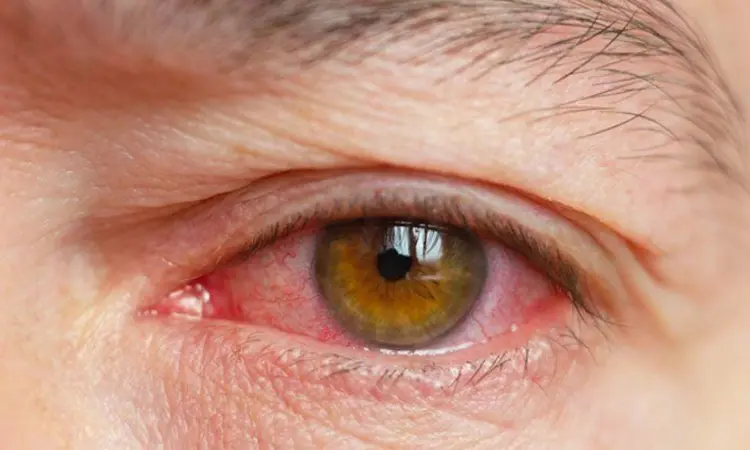- Home
- Medical news & Guidelines
- Anesthesiology
- Cardiology and CTVS
- Critical Care
- Dentistry
- Dermatology
- Diabetes and Endocrinology
- ENT
- Gastroenterology
- Medicine
- Nephrology
- Neurology
- Obstretics-Gynaecology
- Oncology
- Ophthalmology
- Orthopaedics
- Pediatrics-Neonatology
- Psychiatry
- Pulmonology
- Radiology
- Surgery
- Urology
- Laboratory Medicine
- Diet
- Nursing
- Paramedical
- Physiotherapy
- Health news
- Fact Check
- Bone Health Fact Check
- Brain Health Fact Check
- Cancer Related Fact Check
- Child Care Fact Check
- Dental and oral health fact check
- Diabetes and metabolic health fact check
- Diet and Nutrition Fact Check
- Eye and ENT Care Fact Check
- Fitness fact check
- Gut health fact check
- Heart health fact check
- Kidney health fact check
- Medical education fact check
- Men's health fact check
- Respiratory fact check
- Skin and hair care fact check
- Vaccine and Immunization fact check
- Women's health fact check
- AYUSH
- State News
- Andaman and Nicobar Islands
- Andhra Pradesh
- Arunachal Pradesh
- Assam
- Bihar
- Chandigarh
- Chattisgarh
- Dadra and Nagar Haveli
- Daman and Diu
- Delhi
- Goa
- Gujarat
- Haryana
- Himachal Pradesh
- Jammu & Kashmir
- Jharkhand
- Karnataka
- Kerala
- Ladakh
- Lakshadweep
- Madhya Pradesh
- Maharashtra
- Manipur
- Meghalaya
- Mizoram
- Nagaland
- Odisha
- Puducherry
- Punjab
- Rajasthan
- Sikkim
- Tamil Nadu
- Telangana
- Tripura
- Uttar Pradesh
- Uttrakhand
- West Bengal
- Medical Education
- Industry
Climate Factors Linked to Dry Eye Symptoms: Study Reveals Impact of Relative Humidity

Spain: Dry eye disease (DED) is a common ocular condition that can lead to discomfort and vision-related problems. A new study published in Contact Lens & Anterior Eye: The Journal of the British Contact Lens Association conducted in Spain by R. Martin and colleagues has shed light on the potential impact of climate factors, specifically relative humidity (RH), on the prevalence of dry eye symptoms among patients in primary eye care practice.
The study involved a cross-sectional analysis of 1,033 patients classified as either non-DED (Ocular Surface Disease Index, OSDI ≤ 22) or DED (OSDI > 22). The participants were part of a multicenter study across Spain. Participants were categorized based on the 5-year RH value of their place of residence, obtained from the Spanish Climate Agency. Two groups were formed: individuals residing in locations with low RH (< 70%) and those in places with high RH (≥ 70%). Additionally, the study assessed daily climate records from the EU Copernicus Climate Change Service to identify any differences in climate variables between participants with and without DED.
Key Findings:
- The prevalence of DED symptoms was found to be 15.5%, indicating that a significant portion of the population experiences discomfort related to dry eyes.
- Participants residing in areas with RH < 70% showed a higher prevalence of DED symptoms (17.7%) compared to those living in locations with ≥ 70% RH (13.6%).
- While the difference was statistically significant, the adjusted odds ratio (OR) was 1.34, which was not statistically significant.
- This risk was comparable to previously established DED risk factors such as age over 50 years and female sex.
- Certain climate variables, including mean wind gusts, atmospheric pressure, and mean and minimum relative humidity, demonstrated statistically significant differences between participants with DED and those without.
- However, these variables did not significantly increase the risk of DED (OR close to 1.0).
The study presents findings regarding the influence of climate variables, particularly relative humidity, on dry eye symptoms. Individuals living in places with RH levels below 70% were more likely to experience DED symptoms, even when adjusted for age and sex. These results emphasize the role of climate in ocular health and support the inclusion of climate data in DED research.
The study's insights may have implications for clinical practice, helping eye care professionals better understand the environmental factors that contribute to dry eye symptoms. As researchers continue to explore the relationship between climate and ocular health, the findings could lead to more tailored interventions and treatment strategies for individuals affected by dry eye disease.
Reference:
Martin, R. (2023). Symptoms of dry eye related to the relative humidity of living places. Contact Lens & Anterior Eye: The Journal of the British Contact Lens Association, 46(4), 101865. https://doi.org/10.1016/j.clae.2023.101865
Dr Kamal Kant Kohli-MBBS, DTCD- a chest specialist with more than 30 years of practice and a flair for writing clinical articles, Dr Kamal Kant Kohli joined Medical Dialogues as a Chief Editor of Medical News. Besides writing articles, as an editor, he proofreads and verifies all the medical content published on Medical Dialogues including those coming from journals, studies,medical conferences,guidelines etc. Email: drkohli@medicaldialogues.in. Contact no. 011-43720751


